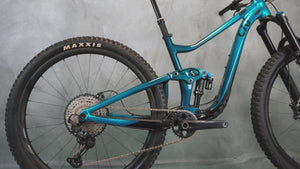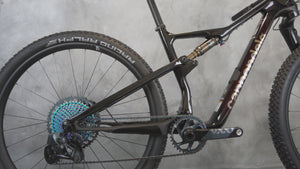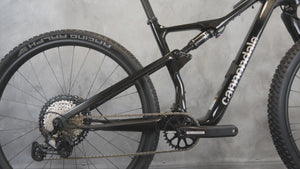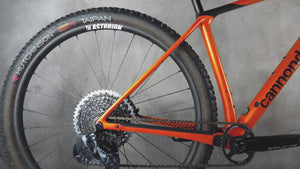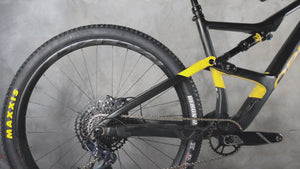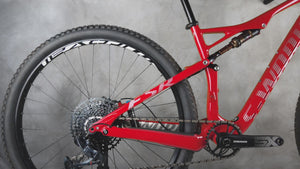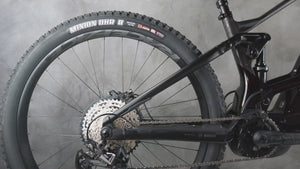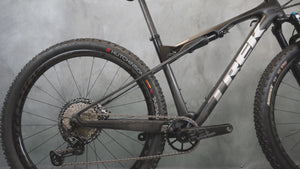How to choose a telescopic seatpost?
In this Article
Posted May 23, 2022
Among the number of possible improvements for a mountain bike, the telescopic seatpost is part of the top 3 for almost all mountain bikers. There are five key factors that allow you to choose a telescopic stable rod:
- Type of sheath passage: interior or exterior
- Diameter of the saddle tube
- Racing length
- Insertion length
- Desired saddle height
A telescopic seatpost, commonly known as "dropping", allows you to quickly adjust the height of the saddle without you having to get off your bike or even stop rolling. It is essential today if you practice mountain biking on a little technical terrain, because it opens a much wider field of action to you, without having to stop and manually move your rod to attack you with trails steep.
In this guide, we tell you everything about the telescopic seatpost and how to choose the most suitable for your needs.
Besides, if you are thinking of buying a mountain bike or you are simply curious, go to our Used mountain bike buying guide.

The choice of telescopic seatpost is vast: travel options, lengths, saddle tube diameters ... How to find your way? Follow our guide!
A little story: the telescopic seatpost is not a new idea
Since the first days of mountain biking, cyclists have been aware of the potential of a lowered seatpost for the descent of technical trails. For many years, the humble quick tightening saddle necklace was an improvised telescopic rod, but it requires stopping, then dismantling, then getting back in the saddle for the climbs.
In 1984, Joe Breeze and Josh Angell presented the Hite-Ro, a seatpost accessory which allowed mountain bikers to lift or lower their saddle in a few seconds, even riding. This type of helical spring option with mechanical levers mounted under the saddle was among the first real stables of the seat, but they had limits. Having a trigger mechanism under the saddle is not very practical either because it forces cyclists to remove their hands from the handlebars.

Photo: Factoryjackson.com
The great technical innovation occurred with the launch of the RockShox Reverb telescopic seatpost in 2010, and marked the start of the downward seatpots remotely, using a handlebar lever, controlled by a trigger hydraulic and a pneumatic spring.
Most telescopic stools work through a cable, although there are a few wireless electric telescopic stalks. And since we speak electric, don't forget to read our article on our tipsTo choose an electric mountain bike.
Nowadays, the telescopic stools operate using a lever, generally located on the handlebars. By pushing the lever, we pull on the cable, which pulls on the actuator of the restraint bar and allows the latter to go up or down. In other words, when you are seated, push the lever and the weight of your body will bring the saddle down. When you stand up, press the lever again and the saddle will automatically rise in the predefined driving position.

Photo: Brian Gerow, Singletracks
An important point for the proper functioning of your telescopic seatpost is to have your well -maintained mountain bike,To do this, consult our MTB interview guide for beginners.
The different options of telescopic sill stems for mountain bikes
The choice of a telescopic seatpost is not entirely based on personal preferences. Elements such as cable passage, diameter, and total length of the stem must be taken into account before deciding. The good news is that there is a wide choice of options.
Each category of mountain bikers uses the telescopic saddle in a slightly different way. For cross-country runners, a telescopic upper helps them obtain a slightly lower center of gravity to better navigate short and technical descents while enduro runners can easily pedal up before going down the rod for a descent . Thanks to the possibility of radically modifying the height of the saddle at any time, you can use the weight of your body and your posture to weigh down or lighten the bike in turns, jumps and on the technical elements.
A telescopic seatpost will certainly help you better roll in the mountains, and what could be better than riding with your four -legged friend? If you too are one of those who take their dog wherever they go, read our Guide to enjoy the mountain with your dog.
How to choose the right telescopic seatpost?
To choose the right telescopic seatpost you must have in mind the following five characteristics:
Passage of the sheath: interior or exterior?
One of the first things to verify before buying a telescopic seatpost is to determine with what type of sheath passage, interior or outdoor, your bike is compatible. Indeed, the cable of the telescopic seatpost can be routed either by the interior of the frame of your bicycle, thanks to a series of canals and integrated holes, or from the outside, thanks to straps or necklaces of Tightening.
Diameter of the saddle tube
The seat stems are available in diameters of 27.2 / 30.9 / 31.6 and 34.9 mm. It is essential to match the diameter of the seatpost to the diameter of the saddle tube. A simple tip for finding the info is to remove your current stem, and search for the printed/engraved numbers on it, or you can also consult the specifications of your online bike.

Photo: Worldwide Cyclery
Travel length / length of the telescopic seatpot
The "running length" corresponds to the maximum distance on which the seat can rise or lower when the rod is activated. For the Enduro, Trail or Downhill it is recommended to use a descent rod with greater travel. This not only increases security, but also to have more margin to attack descents.
If you are looking to buy a telescopic seatpost for a Gravel or Cross-Country bicycle, we recommend that you opt for a smaller race rod. The total length of the support bar is directly linked to the length of the travel (that is to say, the longer the travel, the longer the stem). Since these types of bikes often have obstructions in the saddle tube which prevent the insertion of a drooping rod in relation to modern mountain bikes, it is likely that your bike is only compatible with a shorter drooping rod.
You must also know the length of the seatpost. The total length of most of the stems is measured between the lower edge of the post to the upper pliers of the cradle (where the rail of the saddle is located). For telescopic saddle rods, this measurement is always carried out when the stem is in full extension. By knowing the length of your current stem, you will know if the stem you plan to use will be suitable. The travel of the telescopic seat stems varies between 65 mm and 200 mm.
Insertion length
The insertion length corresponds to the part of the rod which is inside the frame: it is the distance between the top of the collar of the seatpost and the bottom of the rod. As some internal passage stems have pieces that go beyond the bottom of the rod (for example, the RockShox Reverb Stealth and KS Integra versions), you will also have to take this into account. This can become a more important problem when using a long travel rod on a small frame.
Desired saddle height
The last step when you change the seatpost is to know / measure your current saddle height in order to make sure that your telescopic seatpost will allow you to reproduce your current configuration. 
The right way to measure your saddle height is from the center of the axis of the crank to the top of the saddle (see image above).
Latest useful tips: do not try to "cut as closely as possible" or have the rod slammed on the frame, as this is risky. Similarly, if you want to adapt a smaller frame to a longer rod, keep in mind the minimum insertion line and be careful never to install/use a rod beyond this line.
Our three favorite telescopic seatpost models for 2022
Fox Transfer Performance Elite
- Weight: 636g
- Race length: 100mm, 125mm, 150mm, 175mm, 200mm
- Diameters: 30.9 mm, 31.6 mm.
- Maximum length: 308.6 mm (100 mm race), 363.5 mm (125 mm stroke), 418.3 mm (150 mm), 475.1 mm (175 mm stroke), 530.7 mm ( 200 mm race)

Photo: Bikeradar
The Fox Transfer Elite Fox Transfer Telescopic Stem is a classic. For 2022 Fox has updated its Transfer seatpost, by reducing the weight, the insertion depths and adding a 200 mm running length option. Fox also released a new 1X handlebar and facilitated the maintenance of internal components.
One of our favorite new features is the low -profile saddle necklace which maintains the height of the stem at a minimum of 44 mm and releases a lot of space to move your body in steep descents.
RockShox Reverb Axs
- Weight: 650g
- Race length: 100mm, 125mm, 150mm, 175mm, 200mm
- Diameters: 30.9mm, 31.6mm, 34.9mm
- Maximum length: 440 mm

Photo: Sram
The Reverb Axs telescopic seatpot is the flagship model of RockShox. Drawing on the performance of the hydraulic reverb, the electric AXS goes even further in the ease of use.
The button is particularly light and easy to activate, and the stem does not require a lever to be activated, which makes its use more intuitive, even on damaged terrains. The absence of cables considerably facilitates assembly.
KS Lev Integra
- Weight: 484g (without remote control or cable)
- Race length: 100mm, 125mm, 150mm, 175mm
- Diameters: 27.2mm, 30.9mm, 31.6mm, 34.9mm
- Maximum length: 450 mm

Photo: Offroad.cc
The KS Lev telescopic seatpot is light, inexpensive, available in many options and more reliable than most of its competitors. It has been on the market for some time now but it remains a safe bet.
Its low weight will appeal to cross-country/trail runners, and there is even a 27.2 mm version (100 mm race) for semi-rigid bikes or Gravel.
In conclusion
"I prefer 1000 times a mountain bike with a rigid frame and a telescopic seatpost with an all-suspendent mountain bike with a classic stable rod" It is the opinion of Tomas Lemoine, vice world mountain biking slopeslyle. After trying it, the practice of mountain biking will become almost a different discipline compared to what you know. If you are looking for a new mountain bike, a telescopic seatpost will be one of the main components to take into account.
See all our mountain biking at The Cyclist House.
And if you already have a mountain bike but with a rigid rod and you decide to switch to a telescopic seatpost, let us know in the comments! You will quickly see that it becomes as necessary as having well inflated tires or anyWhat other essential equipment for a mountain bike outing.






















